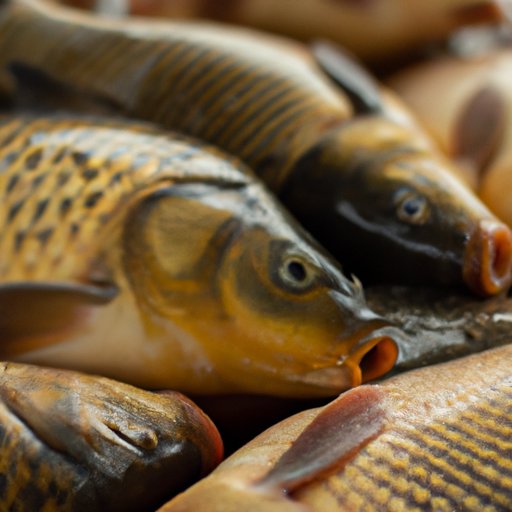
Introduction
Fishing for and consuming carp has been a tradition for many cultures across the globe for centuries. However, many people in the Western world are not as familiar with this fish. If you’re considering trying carp for the first time, you may have some questions about the safety and taste of this unique fish. This article aims to explore all that you need to know about eating carp, including its nutritional value, sustainability, and how to cook it.
Carp Cuisine: Is Eating Carp Safe and Delicious?
Carp has a rich history of consumption across different cultures. In Europe, for example, carp is traditionally served during Christmas Eve dinner. In Asia, carp is a commonly consumed fish that represents a symbol of good luck. Carp is a freshwater fish that tends to have a mild taste. Unlike saltwater fish, there is no unpleasant “fishy” taste or odor associated with carp, which may make it more palatable for those who are sensitive to these factors.
Carp also provides numerous nutritional benefits. Carp is a fatty fish, which provides omega-3 fatty acids. Omega-3s have been shown to reduce inflammation within the body, lower cholesterol levels, and improve heart health. Carp is also a good source of protein, which is essential for building and repairing tissue in the body.
However, there may also be some potential health concerns associated with eating carp. Carp has been known to carry parasites like tapeworms and nematodes, which can be harmful to humans if consumed. Therefore, it is important to ensure that carp is cooked thoroughly before eating to kill off any potential parasites. Additionally, pregnant women or people with compromised immune systems should be cautious about consuming carp or any fish with the potential for parasites.
Sustainability and Carp Consumption: Why Eating Carp Could Help the Environment
Carp are invasive species in many freshwater ecosystems, meaning they are not native and tend to outcompete other species for resources. Invasive species can cause negative environmental impacts, disrupting local ecosystems and damaging biodiversity. Carp, in particular, can pose problems for native species by stirring up sediment at the bottom of ponds or lakes, which causes water to become murkier overall.
However, there is a potential solution to the problems caused by invasive carp populations: eating carp. By promoting the consumption of carp, we create a demand for the species and provide incentives for fishing it. This can help remove excess carp from ecosystems and mitigate some of the negative impacts they cause. Additionally, since carp is such a fatty fish, it can be utilized in a variety of different dishes, making it a valuable food source.
From the Lake to the Plate: A Guide to Preparing and Cooking Carp
If you’ve never prepared carp before, it can seem a bit intimidating. However, with some basic knowledge and the right preparation, it can be a delicious and nutritious addition to your diet. Start by cleaning the carp thoroughly and removing all the scales, making sure to cut off the head and tail. Begin by filleting the carp into pieces that are about 1 inch thick. Then, depending on the recipe you choose, you may choose to cook it using a variety of different techniques, such as smoking, frying, baking, or grilling.
Here are a few ideas for ways to prepare carp:
– Smoked carp: Brine the carp fillets for at least 24 hours. Then, smoke the carp over hickory or applewood for several hours. Serve hot or cold as a spread or on a cracker.
– Fried carp: Bread the carp in a mixture of flour, cornmeal, and spices like paprika and cayenne pepper. Fry in oil until golden brown.
– Carp tacos: Season the carp fillets with chili powder and cumin, then bake or grill until cooked through. Serve on warm corn tortillas with avocado, lettuce, and a squeeze of lime.
Carp versus Other Fish: How Does It Measure Up?
When compared to other popular fish varieties, carp is distinctive in a few different ways. Firstly, it is a freshwater fish that tends to have a milder taste than many saltwater options. Additionally, carp is a fatty fish that is rich in omega-3 fatty acids. Other popular fish varieties like salmon, trout, or haddock may also provide these same nutritional benefits.
However, other fish may have a higher level of contaminants like mercury or other toxins. Therefore, it is wise to vary your fish consumption to avoid any potential accumulation of contaminants.
The Great Carp Debate: Exploring The Controversy Around Eating This Fish
Carp is not without its controversies when it comes to consumption. Some people are concerned about pollution in freshwater ecosystems and the ways in which this pollution can be harmful to fish and other aquatic species. Additionally, some people have ethical concerns about the treatment of fish during fishing and harvesting practices.
However, there are also arguments in support of carp consumption. As we’ve discussed, invasive carp can be a significant problem in many freshwater ecosystems, and promoting their consumption can help reduce their negative impact and support sustainability.
Conclusion
In conclusion, carp is a unique fish that can provide many nutritional benefits. With a mild taste and high levels of omega-3 fatty acids, it can be a tasty addition to your diet. Additionally, promoting carp consumption can also help reduce the negative impacts caused by invasive carp species.





